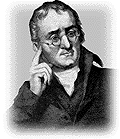
Home
Common Compounds
Exam Guide
FAQ
Features
Glossary
Construction Kits
Companion Notes
Just Ask Antoine!
Simulations
Slide Index
Toolbox
Tutorial Index
Companion Notes
Introduction
Measurement
Matter
| Atoms & ions |
Chemical change
The mole
Gases
Energy & change
The quantum theory
Electrons in atoms
The periodic table
Home  Companion Notes Companion Notes  Atoms & ions Atoms & ions  Dalton's atomic theory Dalton's atomic theory | Print | Comment |
Dalton's atomic theory: Page 1 2 3 4 5 6 Back Next
The law of fixed composition

Quiz: Dalton's Atomic Theory
| Dalton's Atomic Theory | |
|
Page 1: Introduction Page 2: Dalton's assumptions Five steps forward and one step back. Page 3: Atoms in compounds An "invisible hand" fixes atom ratios in compounds Page 4: Atoms in reactions Dance of the atoms Page 5: Learning check Take a quiz on Dalton's Atomic Theory Page 6: References and resources |